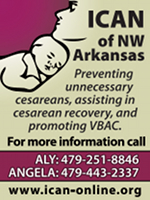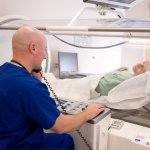 International Cesarean Awareness Network (ICAN) is a nonprofit organization devoted to preventing unnecessary cesareans, assisting women in cesarean recovery and promoting Vaginal Birth After Cesarean (VBAC). We’d like to officially welcome one of our newest sponsors today.
International Cesarean Awareness Network (ICAN) is a nonprofit organization devoted to preventing unnecessary cesareans, assisting women in cesarean recovery and promoting Vaginal Birth After Cesarean (VBAC). We’d like to officially welcome one of our newest sponsors today.
ICAN was founded in 1982 by Esther Booth Zorn, co-author of the TIMES bestseller Silent Knife. Since then, local chapters have formed across the world, including Northwest Arkansas.
We asked NWA Chapter Leader Aly Kirkpatrick to answer some questions about the organization and its mission.
Aly, what services does ICAN offer local mothers? We offer in-person support and education through monthly meetings, on-line information and support through the pages of our site, forums, social networking and more. We also offer an avenue for women to work together to help change the VBAC bans present in our local hospitals. Periodically, Cesarean Prevention classes, Cesarean Healing Circles and VBAC classes are offered. Call 479-251-8446 to register.
What was your own birth experience like? Did it trigger your interest and involvement in ICAN? I, like many ICAN moms, got involved with the cesarean issue after the cesarean delivery of my first baby. Although the cesarean was medically necessary, the situation that led to the surgery wasn’t something likely to be repeated. The cesarean experience was traumatic for me and I had little support in my recovery.
This, coupled with the fact that VBAC is safer than repeat cesarean for both baby and mom in the majority of cases, I greatly wanted to try VBAC for subsequent births. It was at that time that NWA hospitals stopped offering VBAC as a service. I felt very alone in my quest for information and support during my second pregnancy. After my son’s VBAC arrival in 2007 I co-founded the ICAN of NW Arkansas chapter to help other moms.
We know you don’t want your organization to be seen as “anti-cesarean” since, in some cases, cesareans are life-saving for both mother and baby. So what is it that you do want more women to understand about the procedure? When a cesarean is necessary the benefits are outweighed by any potential risks. However, the majority of cesareans are preventable. In these cases any potential benefit from a cesarean is by far outweighed by the risks involved. Given proper support and encouragement ICAN believes that 90-95% of women can give birth joyfully, as nature intended.
How does your group help provide support for women recovering from a cesarean? We provide a safe environment for mothers through our support meetings and Cesarean Healing Circles to process the birth in addition to practical tips. Our new brochure titled “Recovering from a Cesarean: Tips on Healing” is very informative. Moms can receive one free of charge by contacting us.
What are some steps a pregnant woman can take to avoid cesarean?
- Choose a caregiver with care! Ideally a care provider should have a cesarean rate of 15% or less.
- Attend independent childbirth classes, such as Bradley or Lamaze
- Educate yourself on your birth options, rights and responsibilities
- Hire a doula or labor assistant
- Read many normal birth stories and watch birth videos to get an idea for how diffferent each labor is
- Eat a well balanced diet and exercise
What do you want women to know about the risks of the VBAC procedure? In less than 1% of moms with a cesarean history the uterine scar gives way, either in labor or pregnancy.* This is called uterine rupture. It can be asymptomatic and not cause any problems or be symptomatic and cause an emergency situation. In the latter an emergency cesarean would be required. Studies show that a VBAC mom who goes into labor on her own has a lower rate of uterine rupture than a mom who is induced or augmented. It is important to note that mother without a cesarean history also has a risk of uterine rupture.
Do most insurance companies cover the costs of a VBAC? Yes!
When and where does the local ICAN group meet? We meet on the 3rd Thursday of each month at the Jones Center for Families, Rm. #155 from 6:30-8. Lap babies are welcome and low-cost childcare is available through the Jones Center.
*Source: The risk of uterine rupture is shown to be 0.87% (1 in 115) in Mercer, B.M., & Gilbert, S, et al. Labor outcomes with increasing number of prior vaginal births after cesarean history. Obstetrics & Gynecology. 2008; 111: 285-291






Thank you for this incredible information. I can’t beleive this was just posted yesterday! It is a releif to know that there are options when it comes to giving birth after a ceserean experience.
Thanks Mamas for posting this vital information!! When I considered having another child after my son was born by cesarean (He was breech and we were using a midwife for whom it was illegal to attempt a breech delivery) we were appalled to find that the propaganda being dished out to local moms-to-be was that cesarean was a safe and convenient way to give birth, and that VBAC was completely unattainable in NWA.
We were prepared to go to Harrison if we had another baby, where the head of obstetrics was a former mid-wife who welcomed VBAC candidates AND their midwives. (Hospitals in NWA also wouldn’t allow our midwife in the delivery room with us).
Horror stories and tales of rare tragedies should not be “teaching tools” for expecting parents.